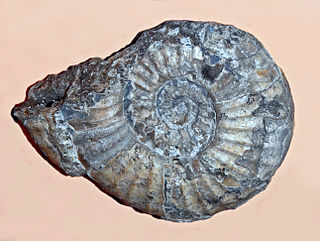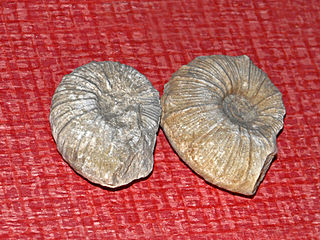Euhoplites is an extinct ammonoid cephalopod from the Lower Cretaceous, characterized by strongly ribbed, more or less evolute, compressed to inflated shells with flat or concave ribs, typically with a deep narrow groove running down the middle. In some, ribs seem to zigzag between umbilical tubercles and parallel ventrolateral clavi. In others the ribs are flexious and curve forward from the umbilical shoulder and lap onto either side of the venter.
Zugodactylites is an extinct genus of ammonite cephalopod from the lower Toarcian epoch of the Lower Jurassic, ammonite zone Fibulatum. Its fossils are found in Europe, Russia and Canada.

Hoplites is a genus of ammonite that lived from the Early Albian to the beginning of the Middle Albian. Its fossils have been found in Europe, Transcaspia and Mexico. Shell has compressed, rectangular till depressed and trapezoidal whorl section. There are strong umbilical bullae from which, prominent ribs are branching and these are interrupted on venter. Ends of ribs on the venter are prominent and can be both alternate or opposite. Some species have zigzaging ribs and these ribs ends usually thickened, or they can be raised into ventrolateral tubercules. These tubercules are mostly oblique clavi.

Psiloceratoidea is a superfamily of Early Jurassic ammonoid cephalopods proposed by Hyatt in 1867, assigned to the order Ammonitida. They were very successful during Hettangian and Sinemurian. Last of them, family Cymbitidae and genera Hypoxynoticeras and Radstockiceras survived into Early Pliensbachian.

The family Dactylioceratidae comprises Early Jurassic ammonite genera with ribbed and commonly tuberculate shells that resembled later Middle Jurassic stephanoceratids and Upper Jurassic perisphinctids. Shells may be either evolute or involute.

Holcodiscus is an ammonite genus placed in the family Holcodiscidae. Species in this genus were fast-moving nektonic carnivores. The type species of the genus is Ammonites caillaudianus.

Cleviceras is an extinct genus of cephalopod belonging to the family Hildoceratidae. These cephalopods existed in the Jurassic period, during Toarcian and possibly even uppermost Pliensbachian age. Sometimes, it is considered to be a synonym of Eleganticeras.
Bettoniceras is genus of ammonite that lived during the Pliensbachian stage of early Jurassic. It evolved from Reynesocoeloceras in Davoei ammonite zone and died out during Margaritatus zone. It is possible that Prodactylioceras evolved from this genus. Fossils of this genus have been found in Europe, Morocco, Tunisia, and Chile. Sometimes this genus is not considered valid, but just as a synonym of Prodactylioceras.
Cetonoceras is genus of ammonite that lived during the upper Pliensbachian stage of early Jurassic. Fossils of this genus were found in Italy, France, Spain, Portugal, Hungary and Austria.
Reynesocoeloceras is genus of ammonite that lived during the lower Pliensbachian stage of early Jurassic, ammonite zones Ibex—Davoei.

The subfamily Reynesocoeloceratinae comprises early Jurassic ammonite genera that lived during Pliensbachian stage. These dactylioceratids existed from Ibex ammonite zone and died out in Spinatum zone. They have evolved from Metaderoceras and gave rise to subfamily Dactylioceratinae.
Peronoceras is genus of ammonite that lived during the middle Toarcian stage of early Jurassic. Members of this genus existed only in Fibulatum Subzone of Bifrons Zone. Their fossils were found in Europe, northern Africa, Asia, North America and South America.
Porpoceras is genus of ammonite that lived during the early and middle Toarcian stage of early Jurassic. Members of this genus existed from uppermost part of Serpentinum Zone to Variabilis Subzone. Their fossils were found in Europe, Asia, North America and South America.
Reynesoceras is genus of ammonites that lived during the upper Pliensbachian stage of early Jurassic. It has evolved from Prodactylioceras, or Cetonoceras. Dactylioceras (Eodactylites) has probably evolved from this genus. Aveyroniceras is a name for macroconchs of this genus. Their fossils were found in Europe, northern Africa, Asia, North America and South America.
Septimaniceras is genus of ammonites that has probably evolved from Peronoceras and lived during the middle Toarcian stage of early Jurassic. Members of this genus existed from Bifrons Subzone to lower part of Variabilis Subzone. Their fossils were found in France, Hungary and probably also in Austria.
Collina is genus of ammonite that lived during lower to upper Toarcian stage of early Jurassic. Members of this genus existed from Braunianus Subzone to Variabilis Zone. Their fossils were found in Europe, Asia, North America and South America. It has evolved from Mesodactylites.
Catacoeloceras is genus of ammonite that lived during middle to late Toarcian stage of early Jurassic. Members of this genus existed from Crassum Subzone of Bifrons Zone to Variabilis Zone. Their fossils were found in Europe, northern Africa, Asia, North America and South America. It has evolved from Peronoceras, or Porpoceras.
Nodicoeloceras is genus of ammonite that lived during early to middle Toarcian stage of early Jurassic. Members of this genus existed from Exaratum Subzone of Falciferum Zone to Commune subzone of Bifrons Zone. Their fossils were found in Europe, northern Africa, Asia, North America and South America. It has probably evolved from Dactylioceras (Orthodactylites) or Kedonoceras and gave rise to Mesodactylites.
Mesodactylites, which is sometimes considered to be a synonym of Nodicoeloceras is genus of ammonite that lived during early to middle Toarcian stage of early Jurassic. Their fossils were found in southern and central Europe and northern Africa. It has evolved from Nodicoeloceras.

The subfamily Dactylioceratinae comprises early Jurassic ammonite genera that lived during Upper Pliensbachian to Upper Toarcian stage. These dactylioceratids existed from Margaritatus ammonite Zone, when they have evolved from Reynesocoeloceratinae and died out in Variabilis Zone without leaving any descendants.







